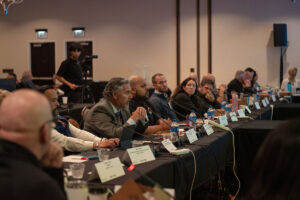
On Sept. 6, 2023, an official from the Department of Energy (DOE) briefed a packed room. A terrorist had stolen radioactive material from the University of Utah hospital. It was Cesium-137, an extremely potent salt compound used in a common medical device —just a pinch of the stuff would make a devastating dirty bomb.
Now what?
This was one in a series of scenarios posed during Wasatch Thunder, an all-day event where nearly 200 people from the University of Utah and local, state and federal agencies practiced their response should someone steal a radioactive source from the U. Co-hosted by the U, the FBI, and the DOE, Wasatch Thunder is part of the “Silent Thunder” program, created in 2008 by the Office of Radiological Security (ORS) to upgrade security for radioactive substances in the country. The ORS’s mission is to enhance global security by preventing radioactive materials from being used in acts of terrorism. They provide support, funding and free training to any institutions with sources in the U.S.
“As a leading healthcare system and research university, we need to have access to equipment that facilitates cutting-edge medical treatment and scientific inquiry. That means dealing with radioactive material,” said Frederick Monette, executive director of Environmental Health and Safety (EHS) and Radiation Safety Officer of the U. “It’s crucial that we provide training, support and emergency responses to use that technology safely. Luckily, we don’t have to do it alone.”
Though highly unlikely, an attempted theft would trigger a massive, coordinated response at all levels, from the U campus to federal agencies. Wasatch Thunder brought all stakeholders to the Salt Lake City Marriott at Research Park to build connections and strengthen protocols ahead of a threat. Two dozen agency representatives spoke, sitting in a semi-circle at the front of the room. The assorted crew embodied the complexity of responding to a radioactive threat. They represented U of U Health hospital security, dispatchers, health physicists, ARUP Laboratories, University of Utah Emergency Management Division, EHS, Department of Public Safety, UPD, Office of the Dean of Students, Marketing & Communications, Intermountain Health, Salt Lake City police departments and fire departments, Salt Lake County Departments of Public Health, Emergency Management and United Fire Authority, Utah National Guard, Utah Transit Authority, Utah Department of Environmental Quality, FBI, and the Department of Energy. Also present were a hundred-plus others who participated in identifying areas where protocols could be improved.
Continue reading Lisa Potter’s “Wasatch Thunder,” and hear the perspective of Edward Cazalas, assistant professor of nuclear engineering in the U’s Department of Civil and Environmental Engineering, on @theU.